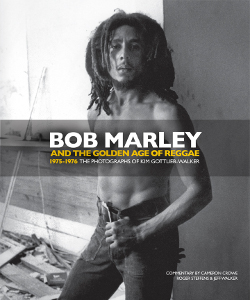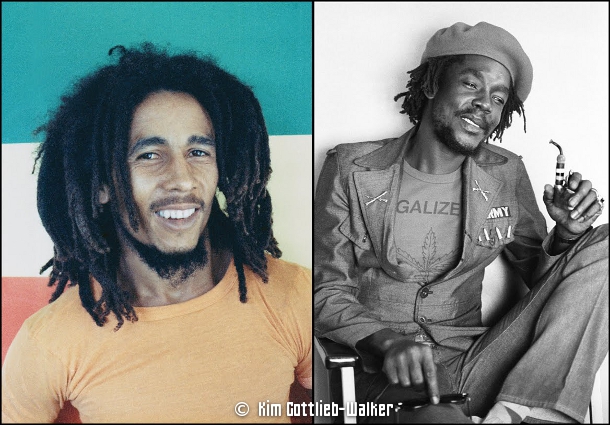Articles about reggae music, reviews, interviews, reports and more...
Bob Marley and the Golden Age of Reggae

Bob Marley and the Golden Age of Reggae
The photographs of Kim Gottlieb-Walker.
The photographs in this new coffee table book are scarcely 35 years old – which isn’t very long in a historical sense - just a drop in the bucket of unfolding time. But, for those of us who came of age during the early years of reggae, leafing through Kim Gottlieb-Walker’s photographs may bring about the strange and uneasy feeling that despite their relative newness, the images seem to represent events from an ancient world, and to belong to a time long passed.
 For reggae fans, the moments that Gottlieb-Walker captured on her trips to Jamaica in 1975 and 1976 reflect the last days of innocence of a music industry and a world that hovered on the brink of change. Bob Marley’s music came to us in the days before every other type of music was measured by its relationship to hip hop, before world music was a term and when an album was a complete statement that could not be fragmented by downloading. The very fact of Bob Marley’s ascendency reflects a time when risks were willingly taken, and in the optimism of the post sixties world, the universe outside our gates was compelling, interesting and exotic - and not the domain of terrorists real and imagined. Above all, they reflect a time when it was radical to listen to reggae. A time when dreadlocks weren’t a fashion accessory and reggae was dangerous music that was not played in supermarkets or repackaged as lullaby records for children.
For reggae fans, the moments that Gottlieb-Walker captured on her trips to Jamaica in 1975 and 1976 reflect the last days of innocence of a music industry and a world that hovered on the brink of change. Bob Marley’s music came to us in the days before every other type of music was measured by its relationship to hip hop, before world music was a term and when an album was a complete statement that could not be fragmented by downloading. The very fact of Bob Marley’s ascendency reflects a time when risks were willingly taken, and in the optimism of the post sixties world, the universe outside our gates was compelling, interesting and exotic - and not the domain of terrorists real and imagined. Above all, they reflect a time when it was radical to listen to reggae. A time when dreadlocks weren’t a fashion accessory and reggae was dangerous music that was not played in supermarkets or repackaged as lullaby records for children.
In the intervening years, images of Marley - like those of Che Guevera - have been co-opted by fashion and corporate media to become a kind of shorthand for rebellion within safe bounds. For those who grew up in the years since Marley’s death, it may be easy to scoff at the naivete that saw artists like Bob Marley, Bunny Wailer and Peter Tosh as agents of societal change. It may be hard for them to realize the risks that were being taken on all sides to carry reggae out of Jamaica and to the world at large. Gottlieb-Walker’s book chronicles the lives and early days of the pioneers – black and white – who expanded the boundaries of what was possible to convey in a pop song. To look at these photos of a young and vibrant Bob Marley is to be taken back to a time when many believed that three chords played with a rebel attitude and the bass turned up to 11 could change the course of the world and its history.
Time is a funny thing, and these photographs play with our perceptions as the images freeze particular moments for eternity. Gone from the earth for decades, Bob Marley and Peter Tosh will always be as young as they appear in these photographs. We never got to see them age, so the compromises of mid-life, the slight shifts in apocalyptic vision that many of their contemporaries experienced and were judged by, were never rested on their shoulders. Some artists like Bunny Wailer – photographed here in his youthful glory – are still with us, as is Winston Rodney (aka. Burning Spear) captured here as a very young man with none of the creases - deep as oak roots - that now line his face, but sadly many of reggae’s founding fathers passed on long before their natural time. For these men, Gottlieb-Walker’s photographs of these men - so young, electric, crackling like lightning rods with vitality and energy - act as reminders, eulogies for their formative days as well as their enduring influence.

The photographs in this book also point back reflexively at the viewer. For the young, they provide a fine and energetic record of the birth of reggae. For the artists’ contemporaries and older fans, they bring back a time when her subjects were musicians rather than icons. Gottlieb-Walker breaks through the hype as she portrays Peter Tosh as a person who in one image laughs heartily while watching a three year old white boy playing with a turntable. The spontaneous photo of Seeco Patterson relaxing on a pile of lumber as well as the ones that reflect Jacob Miller’s life affirming grin are enough to brighten even the darkest of days. In the end, it is virtually impossible to pick a favourite image from the treasures that reside between the covers of this book.
As impossible as it may seem to fans from the Trenchtown days, lush coffee table books about reggae and Bob Marley are nothing new. Recently released volumes with photos by Adrian Boot and David Burnett have each shed light on Marley’s ever-expanding mythology, but of all these books, ‘Bob Marley and the Golden Age of Reggae’ is really something special. Of all the publications currently available, it is the only one that expresses the Marley behind the image – a Bob Marley who smiles easily and who has not yet perfected the ‘screw face’ he often adopted in later photos.
Sympathetic essays by Cameron Crowe, Roger Steffans, and Kim’s husband Jeff Walker accompany the images, but for the most part, she wisely lets the photos speak for themselves. The book exists in a world where it is forever 1976; there are no recent photos of any of the subjects to break the spell. And what a heady spell it is! Looking through the book, my whole adolescence came back to me as I recalled the first time I heard ‘Burnin’ on my friend’s brother’s turntable, swaying back and forth as we clumsily rolled spliffs to accompany ‘I shot the Sheriff’ and ‘Hallelujah Time.’ The associations and memories that this book brings out will of course vary from person to person, but however these images affect one, it shouldn’t take long to realize that ‘Bob Marley and the Golden Age of Reggae’ is the best book of reggae photographs ever published. I can’t recommend it enough.
Read comments (1)
| Posted by AYPT on 01.23.2011 | |
| That's a great pic of Peter! They're keeping the spirit alive at www.facebook.com/petertosh and twitter.com/petertosh...he may not get as much attention, but his influence is undeniable.... | |
Comments actually desactivated due to too much spams
Browse by categories
Recommended Articles
Latest articles
Recently addedView all
© 2007-2025 United Reggae. All Rights Reserved. Reproduction in whole or in part is prohibited. Read about copyright
Terms of use | About us | Contact us | Authors | Newsletter | A-Z














